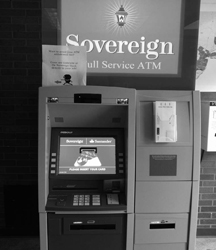Most young adults see credit and debit cards as a means to an end, but do not know the benefits or negative effects they can have on credit scores, making it more difficult to finance future investments.
Sallie Mae published a study in 2009 that discussed how students charge an average of $2,200 in direct education expenses.
Eighty-four percent of undergraduates had at least one credit card, up from 76 percent in 2004. On average, students have 4.6 credit cards, and half of college students had four or more cards. The average (mean) balance grew to $3,173, higher than any of the previous studies. Median debt grew from 2004’s $946 to $1,645, the study concluded.
The most shocking statistic of the study discussed how, “only 17 percent said they regularly paid off all cards each month, and another 1 percent had parents, a spouse, or other family members paying the bill. The remaining 82 percent carried balances and thus incurred finance charges each month.”
Dr. Paul Orzechowski, economics professor at the University, discussed how credit cards can be very dangerous for students if they are not used properly.
“It is a good device to use credit, but a student has to pay it off on time,” Orzechowski continued, “it is best to seek a card that does not have annual fees.”
Orzechowski added, “It is wise to use [a debit card that has a] local base that allows students to have an ATM or debit card, and having access to a bank manager makes it easier to address problems or concerns.”
Aziz Mama, senior finance and accounting major, has a credit card, but acknowledges that it is not wholly his. “I have a credit card that is linked with my parents’ credit cards. In truth, I cannot rightfully say it’s mine, so I take care if I use it since the burden of paying the bill falls mainly on my parents,” said Mama.
Dr. Robert Scott, associate professor of economics further explained the advantages and disadvantages of debit and credit cards.
“Most of the time it has to do with the lack of savings. Some people do not set aside any money, and do not realize the high interest rates and the compounding interest rates and do not understand how expensive that long term is,” said Scott.
Most believe that debit cards can be good to a certain degree, but run certain risks that few college students are aware of. Carrying a negative balance in a checking account can lower students’ credit scores.
Credit cards provide more protections for students, but the main problem is the accessibility of their credit lines.
“The money is always there, and if a student has a reasonably sized credit limit, it is easy to see something and buy it even though the money is not technically there,” Scott said.
Credit cards help build credit scores, and a safe option would be for a student’s parents to put him or her on their credit account. The only disadvantage to this scenario is that student’s will not develop money management skills.
Keeping track of money is key and technology knows that. Web and mobile applications have been developed to help students keep track of what they spend and how they spend it.
“The biggest thing people could do is put some savings away. Even if its twenty dollars a month, or every week, just in case something comes up. Having that money will alleviate some of financial pressures and students will not have to rely on a credit card,” Scott concluded.
The United States government evaluates credit on a scale, ranging from 300 to 850, with 300 as the lowest score and 850 the highest. Students are able to keep track of their Fair Isaac Corporation (FICO) score for free at 1-877-322-8228.
PHOTO COURTESY of Alyssa Gray



